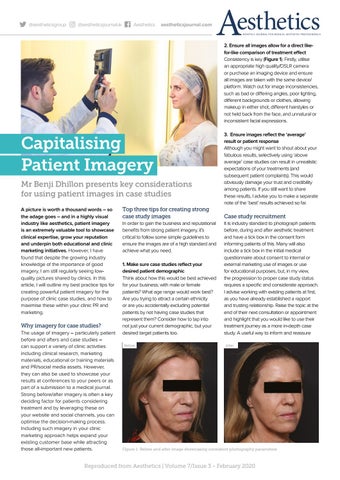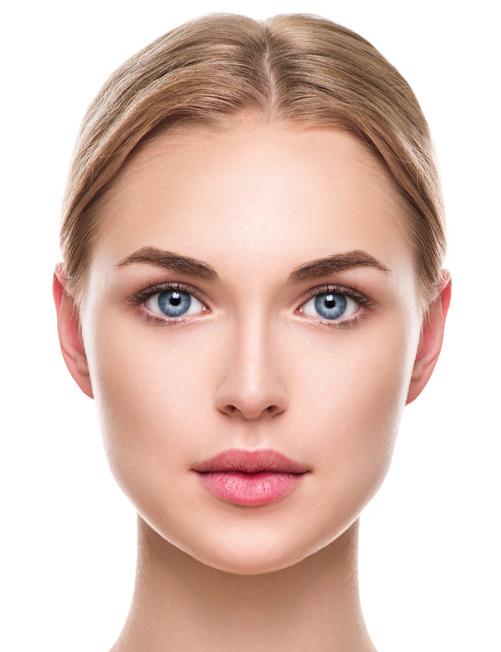@aestheticsgroup
@aestheticsjournaluk
Aesthetics
aestheticsjournal.com
2. Ensure all images allow for a direct likefor-like comparison of treatment effect Consistency is key (Figure 1). Firstly, utilise an appropriate high quality/DSLR camera or purchase an imaging device and ensure all images are taken with the same device/ platform. Watch out for image inconsistencies, such as bad or differing angles, poor lighting, different backgrounds or clothes, allowing makeup in either shot, different hairstyles or not held back from the face, and unnatural or inconsistent facial expressions.
Capitalising Patient Imagery Mr Benji Dhillon presents key considerations for using patient images in case studies A picture is worth a thousand words – so the adage goes – and in a highly visual industry like aesthetics, patient imagery is an extremely valuable tool to showcase clinical expertise, grow your reputation and underpin both educational and clinic marketing initiatives. However, I have found that despite the growing industry knowledge of the importance of good imagery, I am still regularly seeing lowquality pictures shared by clinics. In this article, I will outline my best practice tips for creating powerful patient imagery for the purpose of clinic case studies, and how to maximise these within your clinic PR and marketing.
Why imagery for case studies? The usage of imagery – particularly patient before and afters and case studies – can support a variety of clinic activities including clinical research, marketing materials, educational or training materials and PR/social media assets. However, they can also be used to showcase your results at conferences to your peers or as part of a submission to a medical journal. Strong before/after imagery is often a key deciding factor for patients considering treatment and by leveraging these on your website and social channels, you can optimise the decision-making process. Including such imagery in your clinic marketing approach helps expand your existing customer base while attracting those all-important new patients.
Top three tips for creating strong case study images In order to gain the business and reputational benefits from strong patient imagery, it’s critical to follow some simple guidelines to ensure the images are of a high standard and achieve what you need. 1. Make sure case studies reflect your desired patient demographic Think about how this would be best achieved for your business; with male or female patients? What age range would work best? Are you trying to attract a certain ethnicity or are you accidentally excluding potential patients by not having case studies that represent them? Consider how to tap into not just your current demographic, but your desired target patients too. Before
3. Ensure images reflect the ‘average’ result or patient response Although you might want to shout about your fabulous results, selectively using ‘above average’ case studies can result in unrealistic expectations of your treatments (and subsequent patient complaints). This would obviously damage your trust and credibility among patients. If you still want to share these results, I advise you to make a separate note of the ‘best’ results achieved so far.
Case study recruitment It is industry standard to photograph patients before, during and after aesthetic treatment and have a tick box in the consent form informing patients of this. Many will also include a tick box in the initial medical questionnaire about consent to internal or external marketing use of images or use for educational purposes, but, in my view, the progression to proper case study status requires a specific and considerate approach. I advise working with existing patients at first, as you have already established a rapport and trusting relationship. Raise the topic at the end of their next consultation or appointment and highlight that you would like to use their treatment journey as a more in-depth case study. A useful way to inform and reassure After
Figure 1: Before and after image showcasing consistent photography parameters
Reproduced from Aesthetics | Volume 7/Issue 3 - February 2020













